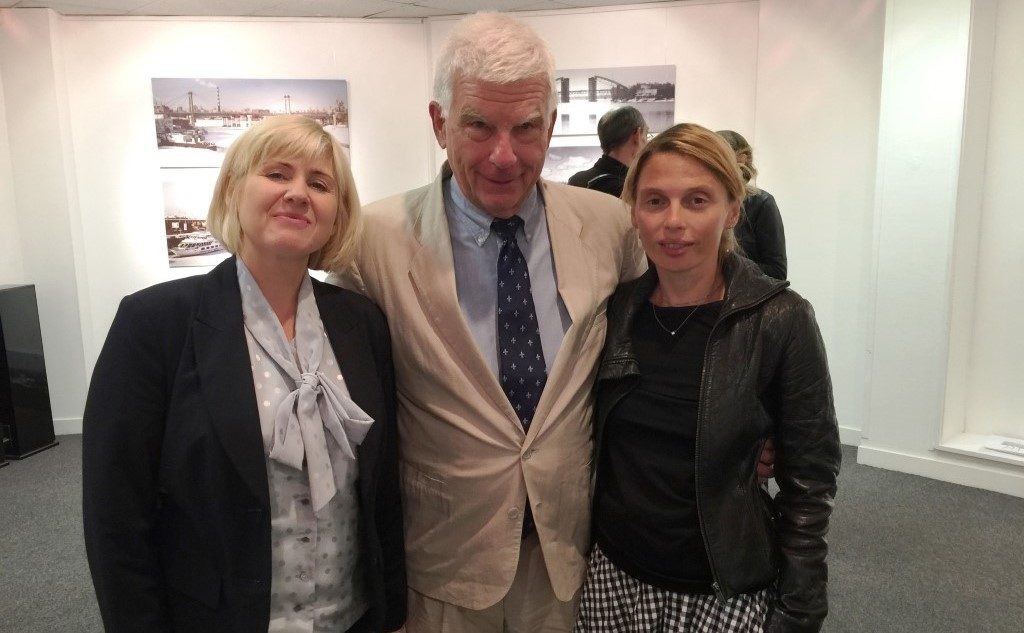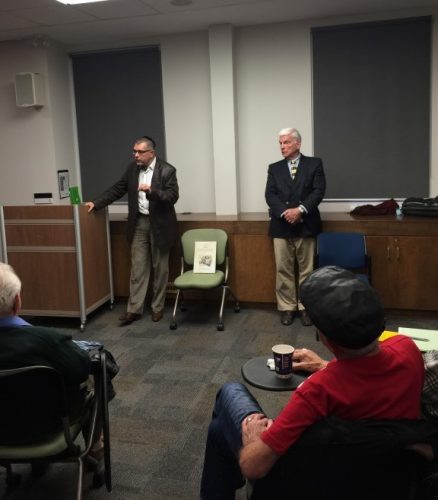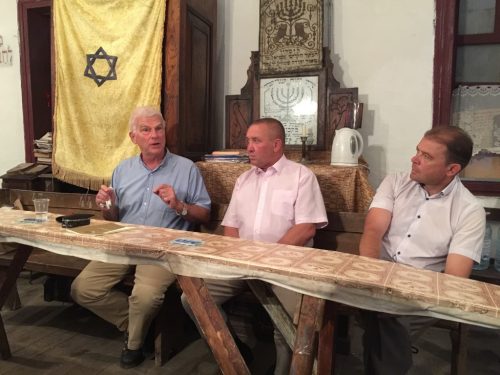Reflections on Jews and Ukrainians: A Millennium of Co-Existence

Three years ago, Paul Robert Magocsi, Chair of Ukrainian Studies at the University of Toronto, started collaborating with Yohanan Petrovsky-Shtern, professor of Jewish studies and Jewish history at Northwestern University, on a book about Ukrainian-Jewish relations. The result was Jews and Ukrainians: A Millennium of Co-Existence, which appeared in both the Ukrainian and English languages. The second edition of the Ukrainian-language volume was recently published in Ukraine, and a new English-language version is expected early in the fall.
Jews and Ukrainians: A Millennium of Co-Existence was supported by a grant from the Ukrainian Jewish Encounter and the Government of Canada and received a special recognition award at the 2016 Lviv Book Forum.
Since its publication in 2016, Professor Magocsi has traveled extensively to promote the book and talk about important aspects of the Ukrainian-Jewish narrative. He will appear in London and Stockholm at the beginning of May, and in several Ukrainian cities in June. Professor Magocsi recently sat down with the Ukrainian Jewish Encounter to discuss the importance of the book, what he learned in the writing process, and his thoughts on audience reactions globally.

Why did UJE decide to support this project?
The Ukrainian Jewish Encounter is a relatively young organization, although one would not think so given the variety of activities it has already carried out. Its primary purpose is to inform the public at large about Ukraine and, in particular, about two of the many peoples that have lived on the territory of Ukraine, that is ethnic Ukrainians and Jews. The UJE’s goal is to inform the world about these two peoples and also how they have interacted. Through knowledge, we hopefully begin to overcome some of the stereotypes, misperceptions, and misunderstandings that have arisen between representatives of these two peoples, as well as the public at large, about Ukraine.
How is this book different from others that have been published about Ukrainian-Jewish relations?
Jews and Ukrainians is in many ways very different than any other book in any other language that has existed before, on this topic or related topics. Most books are not only about Jews in Ukraine or on Ukrainian lands, but also tend in most cases to focus on a particular period or a particular problem. And that particular period or problem is usually related to some very traumatic or negative event in the history of this community—Jews on the territory of Ukraine. It can be the Holocaust in World War II or the pogroms at the close of World War I. There are certainly many publications about the Khmelnytsky era. But again, they are either just about Jews, or focusing on one particular period.
The book Jews and Ukrainians is what it says it is. It is very specifically about Jews and ethnic Ukrainians, two of the many peoples of Ukraine. And it does not focus on one particular period or on any one theme.
Why take this approach?
Most of the studies that exist and that deal with Jews are of a historical nature. Jews and Ukrainians first of all is a survey that discusses both Jews and ethnic Ukrainians on the territory of Ukraine from prehistoric times to the present. It’s a long-span survey, roughly a thousand years. Hence the title, Jews and Ukrainians: A Millennium of Co-Existence.
The other thing is that the book is not a historical survey of these thousand years, but takes what we call a thematic approach. There are twelve chapters in the book and each of these chapters focuses on a different aspect of the life of Jews and ethnic Ukrainians on the territory of Ukraine.
There is an opening chapter on geography: what is the physical space where these two peoples interacted and how did that physical space have an impact on their interactions and certainly their respective evolutions? There is a long chapter on history, plus chapters on economic relations, traditional culture, language, literature, music, art (both painting and sculpture), and the specific evolution of activity in the diasporas. Within each of these thematic chapters, one can discover and learn about the music of Jews, as well as the music of ethnic Ukrainians. One can also learn about how Ukraine inspired world composers.
In effect, what one has access to in this book is general knowledge about ethnic Ukrainians and about Jews. The book is unique in being able to offer how to find out about each of these peoples. It’s also unique in being able to offer how to find out about the various aspects of Ukrainian culture and history, which are usually not all in one book.
Your previous books are known for their unique maps and vivid illustrations. Is this work any different?
To enhance the value of the volume, the book has over 335 illustrations and 24 maps in full color, maps of various things, not only historical evolution and geography. There is even a unique map of the distribution of Yiddish dialects and Ukrainian dialects on one map, which has never been depicted before. It shows sites of the diasporas, particularly in North America, both for ethnic Ukrainians as well as Jews. It serves both as an introduction and is almost like a coffee table book, but a high-end coffee table book.
At the beginning of the book, you have a table that outlines some stereotypes that Jews and Ukrainians have about each other. Why did you decide this was important?
Taking on a stereotype on the simplest level can be problematic. If we apply how stereotypes are used, influence policies of governments, influence the manner in which communities react vis-à-vis other communities, then stereotypes can result in more than insults, but also in wars, ethnic cleansing, and various types of genocidal activity, etc. Stereotypes by their very nature are at best problematic, and at worst incredibly dangerous and deadly. The goal of a book of this kind would be to overcome stereotypes, period.
When it comes to Jews and Ukrainians, stereotypes have led to some very negative and dangerous events. What we decided to do is put on the table a few typical examples—and there are very many others—of how stereotypes or misinterpretations about various historical events or people have developed and evolved. The book that follows—because these stereotypes are mentioned in the introduction—successfully shows, I believe, that life is much more complex. Stereotypes by their very nature require a black-and-white perception of the world. Life and historical development is all gray. There are no black and whites, just various shades of gray, which is a reflection of the complexity of life.
Where are stereotypes more prevalent—in the home country or in the diasporas?
Not everyone may agree with this, but my impression is that stereotypes are much more prevalent in the diasporas than they are in the homeland. I believe the homeland has moved on, as is often the case. For people who emigrate abroad, their mindset stopped at the time they left, whether it was the late 19th century, the interwar years of the 20th century, or during the last twenty years. They think they know their society, but their society has moved on. They’ve moved on also, but not in their own society. They’ve moved on in another society. But they’ve taken stereotypes that have existed before. My impression has always been that stereotypes are much stronger in the diasporas—whether in central or western Europe, Canada, the United States, or Israel—than they are in Ukraine itself, particularly among the younger generations. The younger generation doesn’t even think in stereotypical terms. Fortunately, I might add.

This book was written primarily for a North American audience, but it also was published in the Ukrainian language. Indeed, the second edition just came out. What message do you hope the book conveys to a Ukrainian audience and what questions do you hope Ukrainian audiences, particularly youth, will continue to tackle?
I tell my colleagues and readers at public events in Ukraine that this book was written for another audience, not one in Ukraine in the Ukrainian language. There are some or many things you may know, but it would be interesting to see how someone else interprets them.
What this book does in its Ukrainian translation for the Ukrainian public is to discuss two of the important groups: ethnic Ukrainians, who today are the numerical majority, and Jews, who have played a very important historical role. It will help people in Ukraine, in particular younger generations, to have it laid out clearly, and to emphasize the multicultural and multinational nature of Ukrainian society, past and present.
Part of our outreach is comprised of what already exists in Ukraine, particularly among the younger generations, though they may not always articulate it. And that is, to ask the question what it means to be a Ukrainian. Is a Ukrainian anyone who is a resident and citizen of the state of Ukraine, regardless of their religious or ethnic background? Or is a Ukrainian only someone who belongs to that ethnic group, speaks the Ukrainian language, and is traditionally, but not exclusively, of Eastern Christian faith? Who is a Ukrainian?
My perspective is that Ukraine is a normal European country. Every European country is made up of peoples of different ethnicities and different languages. They maintain those ethnicities, but they live within a country. They are either French, or Italian, or German, or Czech, Polish, Swedish, or Ukrainian. So, Ukrainians are a state people who are comprised of various ethnic and religious groups.
Who knows, one might have spinoffs of a book like this. Why not have a volume done in this format about ethnic Ukrainians and Russians in Ukraine, or ethnic Ukrainians and Poles in Ukraine? Or ethnic Ukrainians and Germans in Ukraine, but not looking at specific matters but the whole gamut? This hasn’t been done before.
You are a world-renowned scholar on Ukraine. Did you learn anything new in the writing of this book?
This is the first time I’ve ever written a book with another author. Why? Did I know something about Jews, and Jews specifically in Ukraine? I did. My large histories of Ukraine, since they are about the territory and deal with all the peoples of Ukraine, include a lot about Jews. But I didn’t know the richness and diversity of the life of Jews in Ukraine that we treat in the book. I fortunately didn’t have to learn it myself because I had a co-author who is a specialist in these matters.
On the other side of the equation, I’ve written a lot about ethnic Ukrainians and I’ve studied Ukraine. I would still need an entire life to learn just as much as I’ve learned up until now. Any society is incredibly rich and complex, and that includes Ukrainian culture in all its aspects. In working on this book, I had vague ideas about life customs, traditions, etc., among ethnic Ukrainians, and I recall a learning curve here. I had to read books about ethnography, about material culture, as well as spiritual culture that I didn’t know or had a vague idea about.
The most inspiring part in working on this book was learning about the incredibly rich tradition of Ukrainian fine arts. We all know about icons, but Ukrainian culture didn’t end with painting icons. There is an entire tradition, particularly in the 19th century and in the early 20th century, of Ukrainian painting and sculpture that is little known, or unknown, in the outside world. Or has been appropriated by other cultures. Some of the great artists who were born, raised, or functioned in Ukraine have been appropriated by Russian culture or described as Russian artists from Russia. Well, they were mostly from Ukraine. [Vasily] Kandinsky is one of the most famous of them. But there are many, many more examples.
Consider Ukrainian classical music. When one says music and Ukraine, they think of folk music and folk dances, etc. That exists, that is an art form, but what about all the operas and symphonic composers in the 19th century and early 20th century among Ukrainians? That is something that by doing this book I was fortunate to learn.
If one were to look purely from a Jewish perspective or a Ukrainian perspective, is there is something someone could learn about their own people in this book?
Absolutely. The Jews are going to learn about Jewish culture and Ukrainians are going to learn about Ukrainian culture. I gave this book to a Jewish neighbor. He picked it up, gave it to his kids and said, “This is a wonderful book. I learned so much about my own culture.”
In retrospect, are there cultural, historical or religious aspects that should have been in the book but are not?
Now is the time to listen to the readers, whether through reviews or through symposia about the book, to get feedback the public, after which, as a result of their comments, I’ll say, ‘Yes, I thought about this or I didn’t think about this’.
You have extensively toured with the book in the United States, Canada, Israel, France, and Ukraine. You’ll visit London and Stockholm in May, and then in June the Ukrainian cities of Kharkiv, Lutsk, and Rivne. What is your impression of audience reaction to the book thus far?
Despite the wide range of audiences in several different countries and presentations in several different languages, the high level of interest on the part of both Jews and Ukrainians has struck me. The reaction to the volume has been generally quite positive.
Interview conducted by Natalia A. Feduschak



















